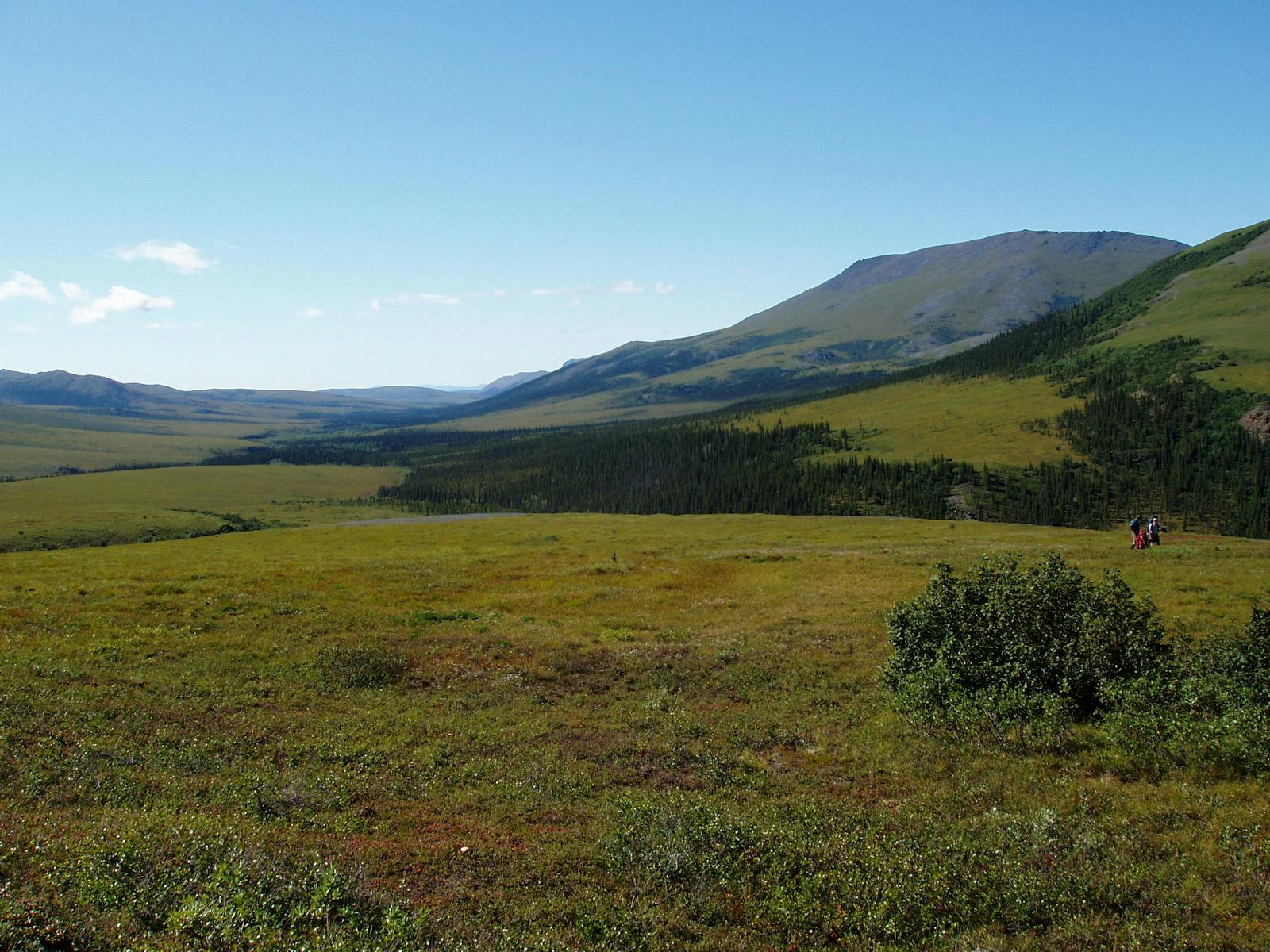Interior Alaska-Yukon Lowland Taiga
The ecoregion’s land area is provided in units of 1,000 hectares. The protection goal is the Global Safety Net (GSN1) area for the given ecoregion. The protection level indicates the percentage of the GSN goal that is currently protected on a scale of 0-10.
Bioregion: Greater Alaska Taiga & Tundra (NA4)
Realm: Subarctic America
Ecoregion Size (1000 ha):
42,448
Ecoregion ID:
375
Conservation Target:
99%
Protection Level:
3
States: United States: AK. Canada: YT
The Interior Alaska-Yukon Lowland Taiga ecoregion sprawls across a large area of southern to northern Alaska and neighboring northwestern Yukon Territory. Varying mostly from sea level to 600 m in elevation (with the highest peak 925 m), the ecoregion is interrupted by a series of mountain ranges covered largely by alpine tundra.
Adjacent ecoregions include Beringia Upland Tundra and Beringia Lowland Tundra on the west, Brooks-British Range Tundra on the north and northwest, Ogilvie-Mackenzie Alpine Tundra and Interior Yukon-Alaska Alpine Tundra on the east, and Alaska-St. Elias Range Tundra, Beringia Lowland Tundra, and Ahklun and Kilbuck Upland Tundra on the south. Major protected areas include the Kobuk Valley National Park and Kobuk National Preserve in Alaska and Vuntut National Park in Yukon Territory.
The Interior Alaska-Yukon Lowland Taiga ecoregion is outstandingly wild. Although only 33% is formally protected, another 27% of the habitat outside protected areas is intact and supports complete food webs, including large carnivores, and natural disturbance regimes.
The climate of the Interior Alaska-Yukon Lowland Taiga ecoregion is mostly continental (high subarctic) but is milder in the west where it borders Norton Sound of the Bering Sea. Summers are short and warm, with average daily maximum temperatures ranging from 17ºC to 22ºC. Winters are long and cold, with average daily minimum temperatures ranging from -35oC to -18oC. The Yukon portion of this ecoregion is more strongly continental, despite its proximity to the Beaufort Sea to the north. Here, mean winter temperature ranges from -27oC to -23.5oC and summer temperature from 7.5oC to 10oC. Average annual precipitation across the ecoregion ranges mostly from 250 mm to 550 mm, but drops to 170 mm in the upper Yukon Flats.

The flagship species of the Interior Alaska-Yukon Lowland Taiga ecoregion is the porcupine barren-ground caribou. Image credit: Creative Commons
The thin soils overlay continuous to discontinuous permafrost, except along rivers. Importantly, parts of this ecoregion were unglaciated during the Late Pleistocene and were part of the extensive Beringia refugium, much of which was a vast grassland known as the Mammoth Steppe. This region was apparently too dry for glaciers to form. The refugium retained many boreal plant species such as black and white spruce, lodgepole pine, birch, and poplar during glacial periods, when areas to the south were ice-covered. These species were then able to recolonize southern areas after the glaciers there receded.i
The modern vegetation of this ecoregion is dominated by spruce forest, with white spruce on river terraces, on timberline sites, and on warmer and drier sites and black spruce in some of these same areas but also in low, poorly drained areas. River meanders are colonized by willow and alder, followed by balsam poplar and quaking aspen, which eventually succeed to spruce.
Scrub communities on disturbed sites, wet areas, north-facing slopes, and near timberline are dominated by willow, alder, and dwarf birch. Bogs contain scrub-graminoid communities with willow, dwarf birch, Labrador tea, bush cinquefoil, and sedges. Lightning-ignited fires occur frequently and maintain a shifting mosaic of post-fire communities in various stages of succession.
This ecoregion provides migratory and wintering habitat for three major herds of barren-ground caribou: the Porcupine, Central Arctic, and Western Arctic herds. The Porcupine herd is noteworthy for its 2,400 km migration in each direction from its winter range in this ecoregion to its calving grounds on the coast of the Beaufort Sea—one of the longest land mammal migrations in the world. In 2017 this herd reached a record high of approximately 202,000–235,000 individuals.ii
-CC-Jan%20Frode%20Haugseth-2010.jpg)
Rock ptarmigan. Image credit: Frode Haugseth, Creative Commons
Other mammals include moose, snowshoe hare, beaver, mink, river otter, marten, muskrat, grizzly near, black bear, wolf, and red fox. Birds include raven, bald eagle, rock ptarmigan, willow ptarmigan, spruce grouse, and many waterfowl. The Yukon Flats is one of the most productive breeding areas for waterfowls in North America, with an estimated 15-20% of the breeding canvasback in the continent, among other species. Chinook salmon spawn in the Porcupine River. Endemic plants from the Beringia refugium include Shaklette’s cryptantha and Alaskan douglasia, among others.
Major threats to this ecoregion include oil and gas development and climate change. Priority conservation actions for the next decade are to: 1) increase the area of land designated for protection—this ecoregion should be able to support at least 50% protection; 2) prohibit new oil and gas exploration and production throughout the ecoregion; and 3) carefully manage harvest of wildlife to prevent hunting-related declines of caribou and other species.
Citations
1. Ricketts, T.H. et al. 1999. Terrestrial Ecoregions of North America: A Conservation Assessment. Island Press, Washington, D.C.
2. Brubaker, L.B., P.M. Anderson, M.E. Edwards, and A.V. Lozhkin. 2005. Beringia as a glacial refugium for boreal trees and shrubs: new perspectives from mapped pollen data. Journal of Biogeography 32:833-848.
3. Elliott-Fisk, D.L. 2000. The taiga and boreal forest. Pages 41-73 in M.G. Barbour and W.D. Billings, eds. North American Terrestrial Vegetation, 2nd edition. Cambridge University Press, Cambridge, U.K.




